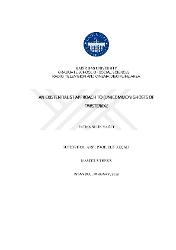| dc.contributor.advisor | Kuyucu, Elif Akçalı | en_US |
| dc.contributor.author | Yağcı, Fatma Selin | |
| dc.date.accessioned | 2020-02-16T16:21:06Z | |
| dc.date.available | 2020-02-16T16:21:06Z | |
| dc.date.issued | 2019 | |
| dc.identifier.uri | https://hdl.handle.net/20.500.12469/2748 | |
| dc.description.abstract | What comes after life has been among the existential questions in philosophy and literature. Cinema, by the virtue of its medium, has the feature of screening what is impossible to show in our world with the tools that belong to this world. Thanks to cinema, impossible appears to be possible on the screen regarding space and time as well as regarding the questionable presence of metaphysical beings. A film taking afterlife and/or ghosts as its main theme deals with invisible or non-existing objects; filming these objects is materializing what is immaterial. Being in between "life and death", "fantasy and reality", "past and present" or "here and there" is usually among the main issues of a ghost film. In this thesis, my main purpose is to understand the depiction of a ghost by comparing the relationship between the cinematic image and the narrative by the example of an unusual ghost film: Finisterrae (Sergio Caballero, 2010). I will concentrate on the topics of life-likeness of an afterlife depiction in this particular ghost film example and existentialism to reveal the communication between the image and the narrative. Additionally, mainly Jean-Paul Sartre's existentialism will be interpreted by comparing the ghosts in his screenplay The Chips Are Down (1948) and the ghosts that are depicted in Finisterrae. Keywords: ghost, afterlife, cinema, existentialism, Jean-Paul Sartre, Finisterrae, life-likeness, narrative | en_US |
| dc.description.abstract | Hayattan sonra ne geldiği felsefe ve literatürde varoluşçu sorular arasında yer almıştır.
Sinema, medyumu sayesinde, gerçek dünyada gösterilmesi imkansız olanı seyirciye sunma
kapasitesi olan bir sanattır. Sinema sayesinde, hem zamansal hem de mekansal olarak
imkansız olan perdede görünür olur. Ölümden sonra yaşamı ya da hayaletleri ele alan bir
film, olmayan ya da görünmeyen varlıkları konu alır, başka bir deyişle, materyal olmayanı
materyalleştirir. Hayalet filmlerinde “arada” olma konusu genelde “ölümle yaşam”,
“fantazi ve gerçek”, “geçmiş ve şimdi” ya da “burada ve orada” arasında mevcut olmuştur.
Hayalet imajın hayatla benzerliği ve gündelik şekilde ifade edilmesini temel olarak
Finisterrae (Sergio Caballero, 2010) ile ele alan bu tezde Finisterrae'de ölümün hayatla olan
benzerliğini inceleyerek, bu benzerliğin filmin ontolojisiyle nasıl bir bağ kurduğuna
bakmak, bu hayalet filmi üzerinden imaj ve anlatı arasındaki ilişkiyi keşfetmek
amaçlanmakta. Ayrıca, özellikle Jean-Paul Sartre’ın varoluşçu felsefesi, onun İş İşten Geçti
(1948) isimli oyunundaki hayaletlerle Finisterrae’nin hayaletlerin karşılaştırılmasıyla
yorumlanacaktır. | en_US |
| dc.language.iso | eng | en_US |
| dc.publisher | Kadir Has Üniversitesi | en_US |
| dc.rights | info:eu-repo/semantics/openAccess | en_US |
| dc.subject | ghost | en_US |
| dc.subject | afterlife | en_US |
| dc.subject | cinema | en_US |
| dc.subject | existentialism | en_US |
| dc.subject | Jean-Paul Sartre | en_US |
| dc.subject | Finisterrae | en_US |
| dc.subject | lifelikeness | en_US |
| dc.subject | narrative | en_US |
| dc.subject | hayalet | en_US |
| dc.subject | ahiret | en_US |
| dc.subject | sinema | en_US |
| dc.subject | varoluşçuluk | en_US |
| dc.subject | Jean-Paul Sartre | en_US |
| dc.subject | Finisterrae | en_US |
| dc.subject | anlatı | en_US |
| dc.title | An existentialist approach to (un)common ghosts of Finisterrae | en_US |
| dc.type | masterThesis | en_US |
| dc.department | Enstitüler, Lisansüstü Eğitim Enstitüsü, Radyo, Televizyon ve Sinema Ana Bilim Dalı | en_US |
| dc.relation.publicationcategory | Tez | en_US |
| dc.identifier.yoktezid | 538303 | en_US |
















